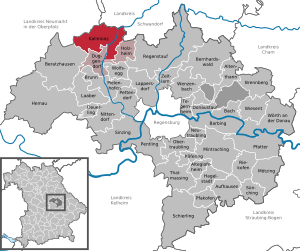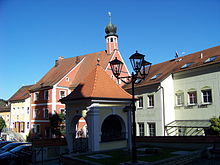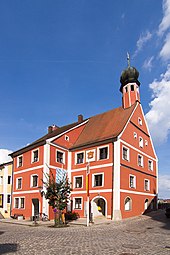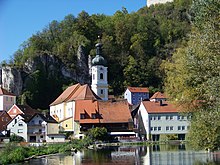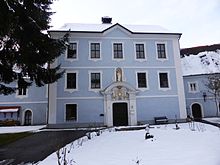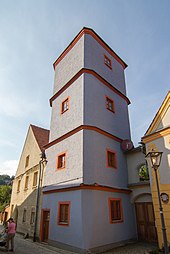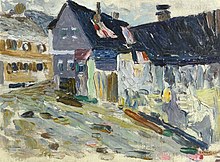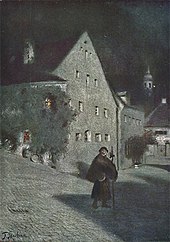Kallmünz
| coat of arms | Germany map | |
|---|---|---|

|
Coordinates: 49 ° 10 ′ N , 11 ° 58 ′ E |
|
| Basic data | ||
| State : | Bavaria | |
| Administrative region : | Upper Palatinate | |
| County : | regensburg | |
| Management Community : | Kallmünz | |
| Height : | 344 m above sea level NHN | |
| Area : | 43.19 km 2 | |
| Residents: | 2799 (Dec. 31, 2019) | |
| Population density : | 65 inhabitants per km 2 | |
| Postal code : | 93183 | |
| Area code : | 09473 | |
| License plate : | R. | |
| Community key : | 09 3 75 156 | |
| Market structure: | 31 districts | |
Market administration address : |
Keltenweg 1 93183 Kallmünz |
|
| Website : | ||
| First Mayor : | Ulrich Brey ( CSU ) | |
| Location of the market in Kallmünz in the district of Regensburg | ||
Kallmünz is a market in the Upper Palatinate district of Regensburg in Bavaria and the seat of the Kallmünz administrative community .
The ruins of the old Kallmünz Castle are located on a ledge of the "Schlossberg" . The castle is a striking landmark in the Naab Valley.
geography
Geographical location
The market is located at the confluence of the Naab and Vils rivers about 25 km north and up the Naab valley from Regensburg on an old trade route to the east. Due to its location, the market is also known as the “Pearl of the Naab Valley”. The mountains of the Bavarian Forest begin 12 kilometers to the east .
Community structure
There are 31 parish parts:
history
An extensive prehistoric complex (approx. 50 ha) from the Bronze Age (approx. 2000–1900 BC) proves the attractiveness of this rock spur between Naab and Vilstal with evidence of settlement from all periods. The place name Kallmünz is traced back to the Celtic * Kalamantia and thus to the same etymon as the name Kellmünz .
Another wall (approx. 900 ) rises up in front of the castle ruins , which is popularly known as the "Hungarian Wall" and thus probably served as a retreat for the population of the area during the Hungarian invasions in the 10th century.
Kallmünz was first mentioned in writing in a document from Bishop Wolfgang in 983. In 1271, a Bavarian ministerial named Hugo von Kallmünz is documented. In the house contract of Pavia 1329, the medieval castle is mentioned for the first time as a property of the Wittelsbach family . The builder and time of construction remain in the dark, based on the architectural styles that can be found, it can be dated to the transition from late Romanesque to early Gothic (approx. 1230–1250).
This castle was pledged by Ludwig the Bavarian in 1344 to Regensburg, later to Thuringia and then to Hesse . A few years later, changing branches of the Wittelsbach family (Pfalz, Upper Bavaria, Pfalz-Neuburg) came back into possession of the castle. During the Landshut War of Succession , Palatine troops set the castle on fire in 1504.
Duke Wolfgang Wilhelm (1578–1653) made Kallmünz the main mint in Palatinate-Neuburg .
After its reconstruction, the castle was initially plundered by the imperial troops during the Thirty Years War . Swedish troops set it on fire in 1641 and finally destroyed it.
For over 100 years, the only cave dwelling in Germany that is still furnished today has been located in the Schlossberg , the "house without a roof".
The late medieval stone bridge (built 1549 to 1558), which was damaged by ice in the 18th century and blown up by the Wehrmacht in 1945 , leads over the Naab . The picturesque, medieval townscape is characterized by old houses that are built under a rocky promontory on the castle rock. Due to its location between two rivers and the steep castle hill, the town center is regularly hit by floods. The painters Wassily Kandinsky and Gabriele Münter became a couple here during the summer vacation of 1903. The place has been a magnet for a small artist colony since the beginning of the 20th century .
Incorporations
On July 1, 1972, Krachenhausen and parts of the previous municipality of See were incorporated. Dinau, Rohrbach and Traidendorf followed on May 1, 1978, as well as parts of the municipality of Fischbach an der Naab ( Schwandorf district ), which was renamed on September 5, 1972 (previously Fischbach ).
Population development
Between 1988 and 2018 the market grew from 2,726 to 2,774 by 48 inhabitants or 1.8%.
politics
Municipal council
The Kallmünzer market council consists of 14 members. After the 2020 local elections, there will be the following distribution of seats in the municipal council :
| Political party | Seats |
|---|---|
| FW | 4th |
| CSU | 3 |
| SPD | 3 |
| Green | 2 |
| CWG | 1 |
| FLKU | 1 |
Of the 2,328 residents in Markt Kallmünz who are entitled to vote, 1,636 exercised their right to vote, bringing the turnout to 70.27 percent.
mayor
In the mayoral election on October 9, 2011, Ulrich Brey (CSU) replaced the predecessor Siegfried Bauer (SPD), who could no longer run for reasons of age. Bauer had held the office since 1993. Brey took office on January 1, 2012.
coat of arms
|
Blazon : "In red under a golden crown three standing diamonds next to each other, the middle silver, the side blue."
The original description in the certificate for the award of the coat of arms in 1455 by Duke Albrecht III. reads: “A coat of arms painted in a letter with a red scabbard and in it three Weckhen from Bayerland, namely two blue ones and a white one in the middle, which have a yellow crown around the same three Weckhen. [...] On the Sunday after George's Day 1455 ”. |
|
Town twinning
Since 1983, a partnership between Kallmünz and Saint-Genès-Champanelle ( Puy-de-Dôme , Region Auvergne-Rhône-Alpes ) in France. Since 2002, there have also been very close relationships with the other partner community of St. Genès-Champanelle, namely Monterosso al Mare ( Liguria , province of La Spezia ) in Italy. The partnership is supported by the Association for the Promotion of Community Partnerships Kallmünz e. V. supervised.
Culture and sights
Churches
- Catholic parish church St. Michael:
Hall building with retracted choir, hip roof and flank tower with onion dome, 1751–58 including early Gothic parts of the wall, around 1250; with equipment. The side altarpiece of St. Sebastian, left side chapel is an important work of museum importance by the painter Josef Wittmann , painter of the neo-baroque style from 1929 and according to the art historian HC Ries.
- Catholic side church St. Sebastian, so-called plague church:
Hall building with retracted choir, hipped gable roof, bell roof ridge and structure of pilasters, 1713; with equipment; former hermitage, single-storey building with hipped roof, around 1730.
- Catholic side church St. Stephan in Dinau:
Eaves building with a retracted apse, with roof turrets with onion dome, Romanesque, roof turrets baroque; with equipment.
- Catholic side church St. Jakobus d. Ä. in Eich:
Hall church with retracted choir and roof turret with onion dome, mid-12th century, remodeled after 1700; with equipment; Cemetery wall, closed bering with segmental arched gate, probably medieval.
- Catholic branch church of the Holy Trinity in Rohrbach:
Choir tower church with pointed helmet, medieval, remodeled around 1680; with equipment; two tombstones, red marble, 1570 and 1592, on the morgue.
- Catholic side church St. Leonhard in Traidendorf:
Eaves and stilted gable roof building with roof turrets, onion hood and plaster structures, around 1684/85; with equipment.
Castles
Three-storey and eaves gable roof construction with plastered structure, house entrance portal and side wings with saddle roof and plastered structure, 1684.
Four-storey residential tower with split cornices, marked 1582.
Four-storey building, 2nd half of the 17th century; In the 19th century one floor was added as a school building
Former hammer lock. Late Gothic three-storey gabled house on the eaves with a laterally offset oriel house from 1586.
Artist colony in Kallmünz
In 1901 , the painter and professor Charles Johann Palmié , who traveled from Munich, chose a newly opened inn in Kallmünz as his domicile during the summer vacation. He also gave the inn the name "Zur Roten Amsel" and illustrated its exterior facade al fresco with his Munich friends . Palmié called Kallmünz the "Pearl of the Naab Valley". Kallmünz soon became an inspiring landscape attraction for painters, who came here in increasing numbers and some of them also settled permanently. As early as 1901, the artist colony had 38 painters. Kallmünz became best known through Wassily Kandinsky's and Gabriele Münter's stay of several weeks in the summer of 1903. Kandinsky then developed a new painting style with which he turned away from representational painting and turned to the abstract art of “color sounds” (as he put it).
What is less well known is that famous Berlin painters also visited Kallmünz. Mention should be made of Franz Skarbina , a friend of Charles Palmié , who was there in 1901. Magnus Zeller , a pupil of Lovis Corinth , visited Kallmünz several times during the Third Reich. Today's most famous of the Berlin painters, Karl Schmidt-Rottluff, was in Kallmünz for at least two weeks in autumn 1936.
The important late Expressionist painter Josef Georg Miller lived in Kallmünz from 1944 until his death in a traffic accident . With his wife Erna geb. Feneberg he took over a pottery in 1944. After the Second World War, the artists ran a children's home.
In 1944 the Nuremberg painter Hermann Buschmann also settled in Kallmünz; he died in 1961 in the Kallmünz nursing home.
From 1975 the painter Hans Geistreiter lived and worked in Kallmünz until shortly before his death. From autumn 1984 he had his own studio for large-scale work. Today there are several galleries that show the works of local artists as well as those of guest artists. Another artist and art sponsor who is involved in the entire region and especially in Kallmünz is Ludwig Bäuml , who has been working in Kallmünz since 1989. The artist group MOSAIK is home to around 20 artists.
Regular events
- Oldtimertreffen (one of the largest in southern Germany with around 700 participating vehicles of all categories), annually, first weekend in June, organizer: Oldtimer-Freunde Kallmünz 1995 e. V.
- triennial bridge festival in July (next date: 2018), organizer 2015: Kultureck e. V.
- Parish fair, annually, at the end of September, organizer: changing
- Christmas market on the second weekend of Advent
- Oven festival, annually, Corpus Christi, organizer: Kallmünz volunteer fire department
- 1st May festival, annually, organizer: Heimat- und Volkstrachtenverein Kallmünz e. V.
- Kallmünzer Spring Run (May), Triathlon (Olympic course) June / July (ATSV-Kallmünz)
- every two years KUNST-SCHAU-NACHT April / May, 2011/2013 (KulturEck Kallmünz, e.V.)
societies
- ATSV Kallmünz: General gymnastics and sports club with more than 1000 members
- Kultureck e. V .: Association for the promotion of culture, organizer of the bridge festival (every three years) and the graphics market
- Bergverein Kallmünz e. V .: Association for the preservation and research of the castle and the castle hill
- Warrior and reservist comradeship from Kallmünz
- Castle riflemen Kallmünz
- Boys' association Naabtal Kallmünz
- Bund nature conservation local group Kallmünz
- Volunteer Fire Brigade Kallmünz e. V.
- Voluntary fire brigade Traidendorf e. V.
- SSC Traidendorf e. V.
- "Die Treuen 1980" FC Bayern Munich fan club
- TTC 1960 Kallmünz e. V.
- "Kallmuenzer Imperial Order" ancient and medieval association
- Oldtimer-Freunde Kallmünz 1995 e. V.
- Friends of Alt-Kallmünz e. V.
- Kultur- und Tourismusverein Kallmünz e. V.
- Heimat- und Volkstrachtenverein Kallmünz e. V.
- Association for the promotion of community partnerships Kallmünz e. V.
Curiosities
Everyone who had citizenship in Kallmünz was also allowed to brew their own beer ( Zeugl -Recht).
The most famous tourist attraction is the “ house without a roof ” in Vilsgasse. This is a small cave dwelling , the entrance of which is closed with a wall with door and window openings.
As Kallmünzer be silicified, very hard sandstones called.
On behalf of the Bavarian King Ludwig I, Domenico Quaglio was looking for a suitable location for the Liberation Hall in Kallmünz and shortlisted a hill opposite the castle ruins.
Public facilities
- Elementary and middle school
literature
- Alois Knauer: Local history of Kallmünz. Laßleben , Kallmülz 1961. Reprint 1994. ISBN 3-7847-1110-3 .
- Kallmünz, the pearl of the Naab Valley. A guide through Kallmünz, its history and cultural history. Laßleben, Kallmülz 1998, ISBN 3-7847-1164-2 .
- Erna Miller: More than 50 years of Kallmünzer Laßleben, Kallmünz 1997, ISBN 3-7847-8166-7 .
- Ruth Sandner: Settlement archaeological investigations on the castle, church and Hirmesberg above Kallmünz. Universitätsverlag Regensburg, 2005, ISBN 3-9304-8047-6 (also dissertation at the University of Regensburg ).
Aerial photography volumes
- The valley of Vils and Lauterach. Pustet-Verlag, Regensburg, 112 pages; ISBN 3-7917-1755-3 .
- The Naab - with Waldnaab, Fichtelnaab, Haidenaab. Pustet, Regensburg, ISBN 3-7917-1915-7 .
Web links
Individual evidence
- ↑ "Data 2" sheet, Statistical Report A1200C 202041 Population of the municipalities, districts and administrative districts 1st quarter 2020 (population based on the 2011 census) ( help ).
- ↑ Markt Kallmünz in the local database of the Bayerische Landesbibliothek Online . Bavarian State Library, accessed on October 27, 2017.
- ^ Albrecht Greule: The historical horizons of the geographical names in Bavaria. University of Regensburg, Faculty for Linguistics, Literature and Cultural Studies, Institute for German Studies, Regensburg 2007 ( PDF 90 kB; published in 2010 in Oberviechtacher Heimatblätter, Volume 8/2010, pp. 9-19), p. 2.
- ^ Wilhelm Volkert (ed.): Handbook of Bavarian offices, communities and courts 1799–1980 . CH Beck, Munich 1983, ISBN 3-406-09669-7 , p. 438 .
- ^ Federal Statistical Office (ed.): Historical municipality directory for the Federal Republic of Germany. Name, border and key number changes in municipalities, counties and administrative districts from May 27, 1970 to December 31, 1982 . W. Kohlhammer GmbH, Stuttgart / Mainz 1983, ISBN 3-17-003263-1 , p. 657, 659 and 667 .
- ↑ https://wahlen.landkreis-regensburg.de/kommunal2020/20200315/09375156/html5/Gemeinderatswahl_Bayern_66_Gemeinde_Markt_Kallmuenz.html
- ↑ http://www.mittelbayerische.de/region/regensburg-land-nachrichten/wahl-in-kallmuenz-knapper-sieg-fuer-brey-21364-art713658.html
- ↑ http://www.wahlen.bayern.de/kommunalwahlen/
- ↑ Entry on the coat of arms of Kallmünz in the database of the House of Bavarian History , accessed on August 5, 2020 .

